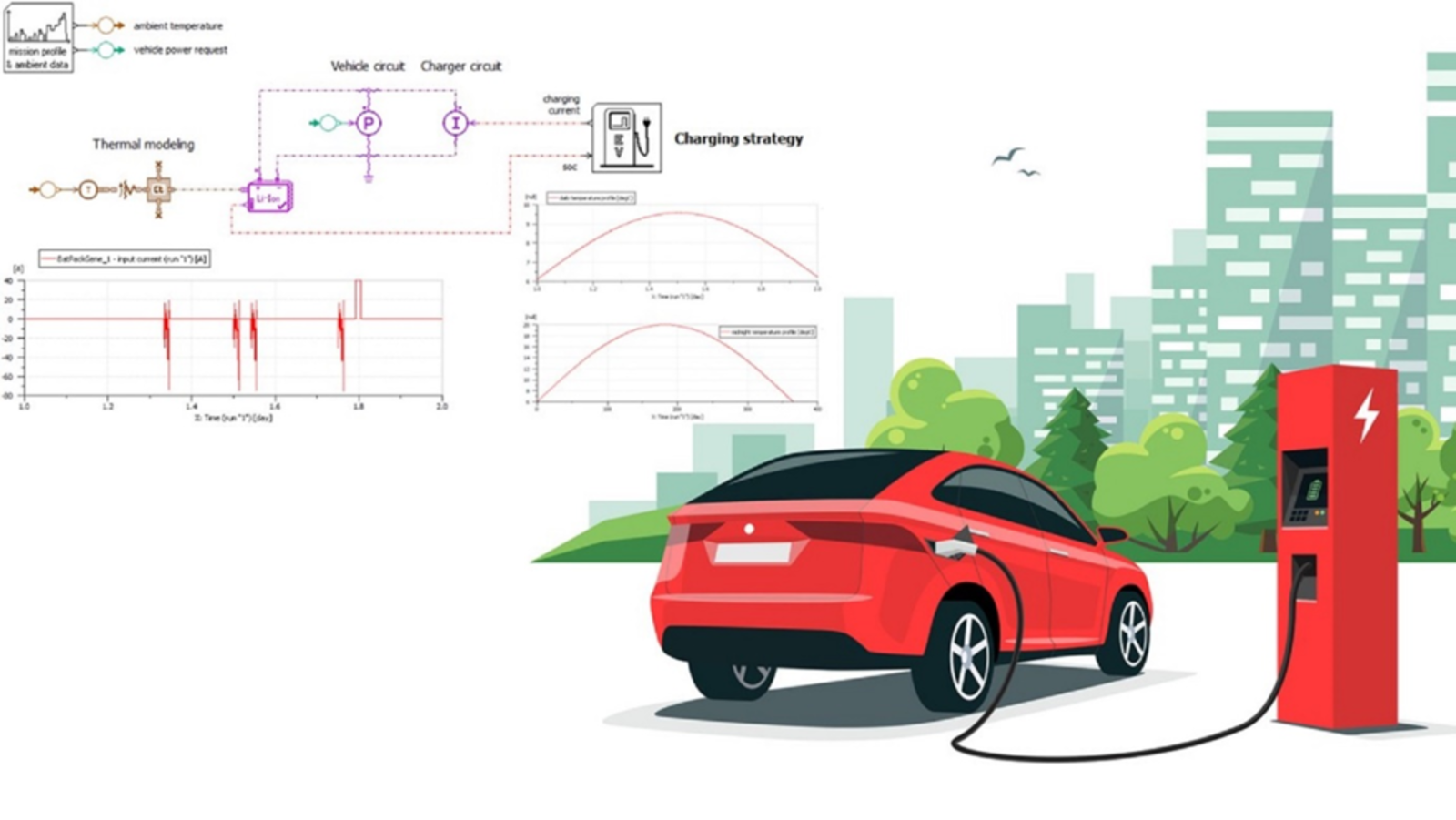Transportation emissions and the climate crisis

Are you willing to recalculate your route?
The total carbon impact of a single flight is so high that avoiding just one trip can be equivalent to going car-free for a year. The question is, what is the likelihood reading that factoid will actually stop you from booking your next trip? If you look at the trends, the safe bet is “not likely”. For better or worse, all the fossil fueled powered cars, planes and boats on this planet are not about to be parked or docked permanently. Current policies presently in place around the world are projected to result in about 2.7°C warming above pre-industrial levels, according to Climate Action Tracker. Going green is the only option. With engineering innovation, significant parts of transport can be decarbonized and prevent catastrophic climate change.
From human-power to steam-power
When humans and horses powered mobility, their carbon emissions were practically nil. But movement was restricted and slow. A horse and wagon could travel 10-30 miles a day, depending on terrain and weather. Transatlantic voyages lasted weeks and were a hotbed for diseases.
The mechanization of transportation was a necessity. It enabled us to practically and safely travel further. And faster. It revolutionized both our own personal mobility and the commercial freight industry. We could go or move products practically anywhere we wanted.
But as we now know that transition came at a cost. The emitted exhaust gases directly increase the atmospheric concentration of carbon dioxide and other greenhouse gases. And they have only grown exponentially over the last century.
The evolution of transportation emissions
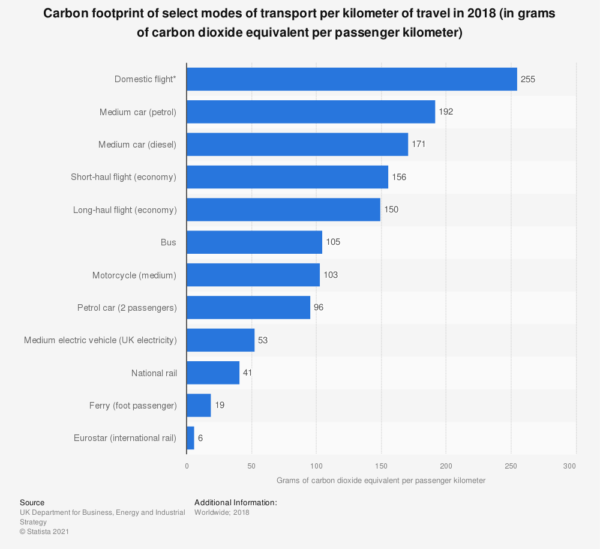
It was only towards the end of the 19th century, with the help of steam-powered engines, that transatlantic voyages became practical and cost-effective for passengers and cargo. My great-grandparents, who immigrated to Canada in 1921, made the journey on a coal-burning ocean liner called the S.S. Megantic.
Had my great-grandparents made the journey from the United Kingdom to Canada in 1830, their sailing boat would have caused almost zero CO2 emissions. However, it would have taken 5 to 6 weeks for them to make the trip.
In 1921, it took seven days to cross the Atlantic. The twin quadruple-expansion-compound marine engines that powered the boat consumed about 1.34 lbs of coal per hour per indicated horsepower. The coal burnt to make the voyage would have released around 550 tons of carbon dioxide, which works out to about 84.7 g CO2 per passenger per kilometer. As you can see in the graph very few modern modes of transport produce so little CO2.
Now, you can fly from London, UK, to Montreal, Canada, in 7.5 hours. In the last century, the world has shrunk by a factor of 20 and by 80 in the last two. However, the carbon footprint has grown substantially. That same return flight from Montreal to London emits as much carbon emissions as heating a European home for an entire year.
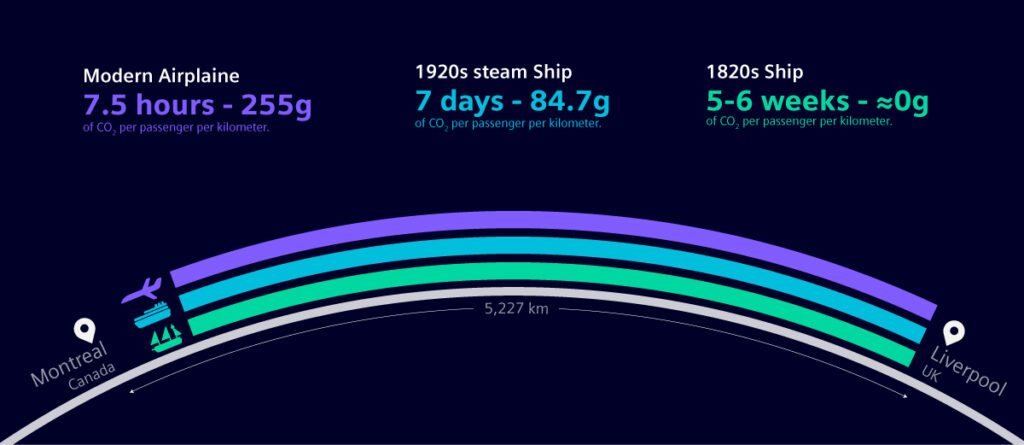
8 billion tons of greenhouse gases
Transportation-related emissions add 8 billion tons of greenhouse gases to the atmosphere every year. That’s 16% of all greenhouse gas emissions. Road vehicles are responsible for nearly 3/4 of the emissions. First, let’s understand how we got to now.
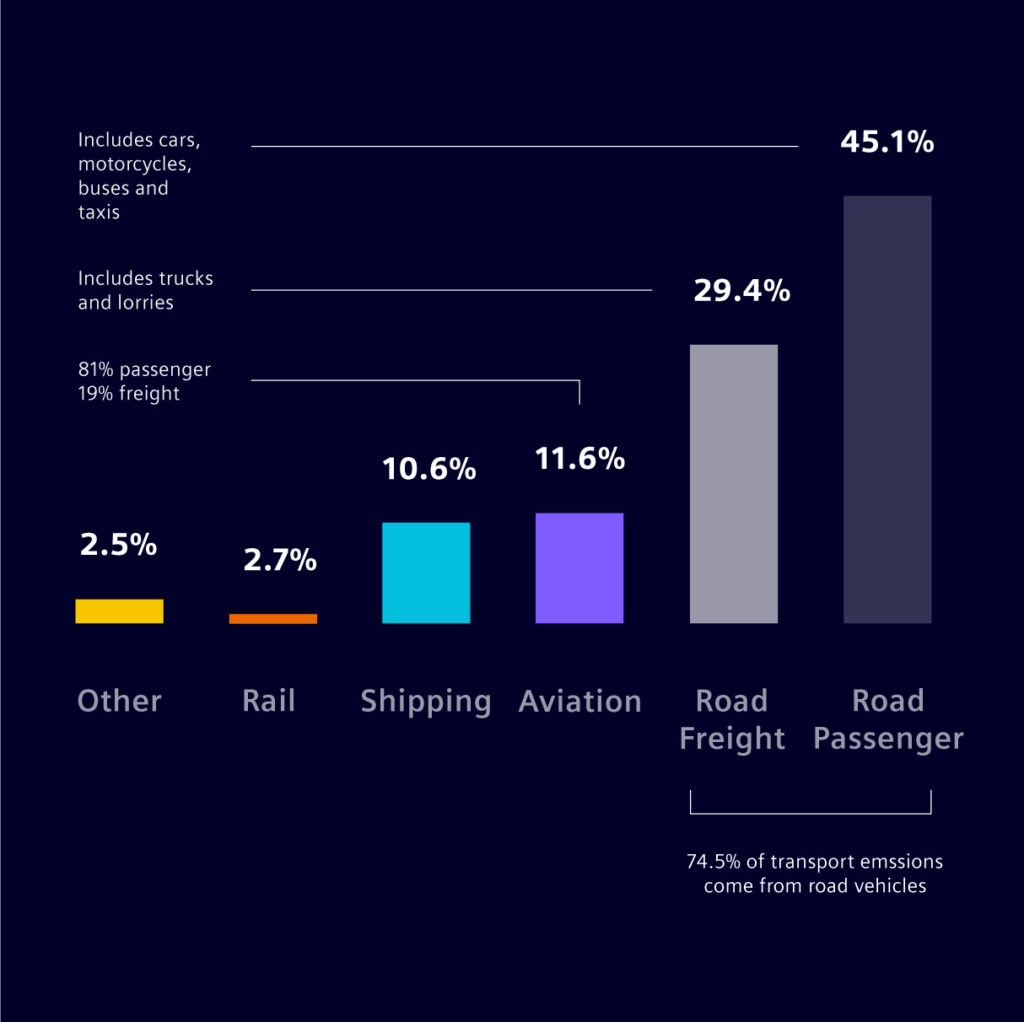
Bertha Benz and the first road trip
Bertha Benz was the wife and business partner of Carl Benz. Together, their work and inventions led to the creation of Daimler AG.
In 1888, Bertha drove her Model III internal combustion engine (ICE) prototype vehicle from Mannheim to Pforzheim. This was both a test drive and a publicity stunt to demonstrate the potential of horseless carriages.
Bertha is widely considered the first person to drive an automobile a significant distance. And to need a gas station. The solvent she needed as fuel, ligroin, was only available in apothecary shops at the time.
It might seem odd to believe, but in the late 19th and early 20th centuries, ICE vehicles faced competition from both steam and electric powered engines. It was not a foregone conclusion which technology would ultimately dominate the automobile industry as all three types had severe limitations, at least initially.
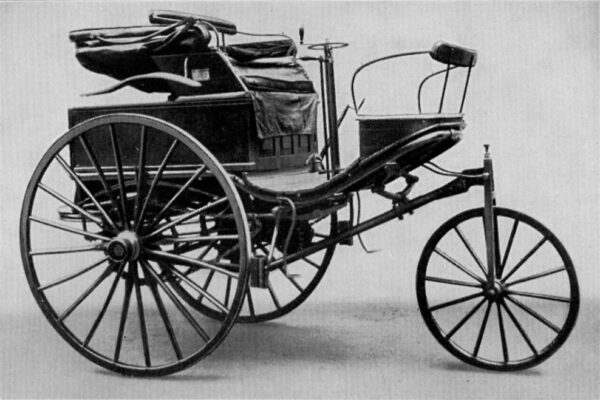
Steam-powered vehicles had limited energy storage capacity and took forever to startup. They also had a rather inconvenient habit of exploding.
The electric cars of that era were quiet and easier to operate than their ICE counterparts. They also had their own drawbacks: the small energy storage capacity limited their range and required a long time to recharge. Sound familiar?
How internal combustion engines came to dominate in road vehicles
ICE were not vastly superior to the alternatives. They were noisy, unreliable, mechanically complex, and difficult to start.
For a brief period, electric and ICE vehicles had comparable ranges on one charge or one tank of fuel.
However, innovations came quickly. In the 1920s, fuel economy was improved and gave ICE vehicles a range advantage. The cumbersome ignition issue was resolved. Henry Ford’s Model T added another advantage: price point. Using assembly lines to manufacture the car made it almost four times cheaper than electric vehicles. With that, steam and electric cars started to disappear.
Although combustion vehicles dominate the road transportation market, their time is limited. Many governments have established legislation to restrict or prohibit the sale of fossil-fueled vehicles in the next decade.
The second era of electric vehicles
Electric vehicles have significantly improved over the past 20 years. In 2001, the Toyota Prius became the first to make significant enduring market penetration. And while it is a success and better for the environment than a pure ICE vehicle, as an HEV, it is not an emission-free car. In truth, there has been minimal adoption of anything but gasoline and diesel-burning vehicles, despite the Intergovernmental Panel on Climate Change (IPCC) growing warnings since 1990 as to the looming danger of greenhouse gases.
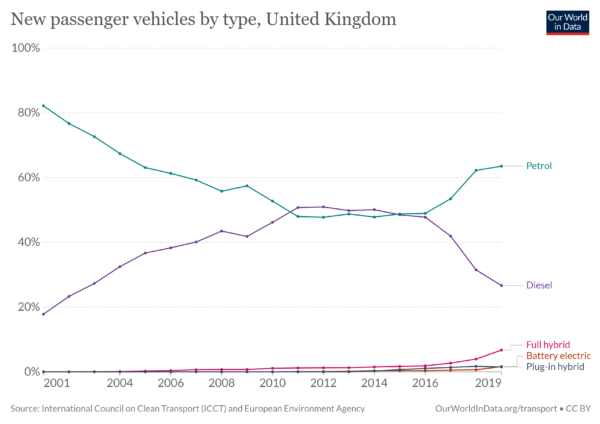
Other alternatives
Electrification is not the only solution. Reaching net-zero by 2050 will require fuel cells, biofuels and other yet-to-be-discovered enhancements. The consensus from organizations like the International Energy Agency, Hot or Cool Institute and Breakthrough Energy is that the electrification of light-duty road vehicles represents the best chance of significantly reducing CO2 emissions by 2030.
“We need to be adopting electric vehicles as fast as we bought clothes dryers and color TVs when those became available.”
Bill Gates, How to Avoid a Climate Disaster
Upstream emissions
Part of the climate math here is avoiding upstream carbon emissions. If we are plugging in instead of fueling up, those kilowatts need to be coming from green energy, or we are just swapping the emission source. Stephen Ferguson’s blog Keeping the lights on in a Climate Emergency explores this issue.
Making EV vastly superior
The same ingenuity that addressed flaws and reduced the cost of early ICE vehicles is what EVs require now. Drawbacks identified over a century ago are still not fully resolved.
The rise of SUVs complicates efforts to rein in auto emissions. Electrifying SUVs is much more complex than smaller vehicles. The additional battery capacity required further increases their weight (which reduces range), drives up their cost over conventional SUVs and prolongs the recharge time.
Batteries remain a key limitation. The challenge is lowering their costs, augmenting their capacity and speeding up recharge times. Improperly shortening charge times can have deleterious effects.
Light weighting electric vehicles helps extend their range. New composite materials that are light and less costly to mass-produce are needed. Simcenter offers multi-attribute solutions for composite materials, including multiscale simulation, allowing for predicting performance for lightweighting.
Charging infrastructure is also critical. It must become as ubiquitous and convenient as gas stations. There are calls for a greater degree of interchangeability between EVs.
At the heart of electrification are the electric motors and inverters. Simcenter solutions can help develop novel traction motors.
Long-haul freight, aviation & shipping
There are limited solutions to decarbonize road freight, aviation, and shipping. At least those that would be practical and scalable. That is why companies such as Airbus explore a wide variety of options.
The weight of heavy-duty freight trucks makes electrification problematic. Gasoline has an energy density of about 46 M.J./kg. The densest battery (just cracking 1 MJ/kg) is still 30-40 times less than gasoline. The weight and space taken by the batteries to allow such trucks to be driven a reasonable time before requiring a recharge would reduce their cargo capacity up to 75%. Further refining current battery technology, such as lithium ions, is unlikely to yield the density required for freight. As a result, significant breakthroughs in battery technology would be needed to make electrification viable.
Electrification would be an option for smaller crafts that fly shorter distances. Cranfield University and Siemens Industry Software have partnered for aircraft propulsion electrification. However, marine, long-haul flights and larger aircraft electrification suffer from the same impracticalities as freight trucks.
Hydrogen
Hydrogen fuel cells could be 3 to 5 times denser than gasoline. It would be an attractive solution for all three subsectors, producing no emissions at the tailpipe. However, as we explore in “Black, Gray, Blue, Purple, or Green: What color is our low carbon hydrogen future?” most hydrogen is currently manufactured from carbon dioxide emitting fossil fuels, and there are considerable challenges ahead in developing significant quantities of green hydrogen, and distributing it around the World.
Ensure the safety of hydrogen mobility explores how Simcenter can help with the research and development to move this forward.
Many countries use nuclear-powered planes and ships for their military craft. However, the technology is mainly unexplored for these commercial purposes due to previous disasters (even though it is safer than wind).
Biofuels
Biofuels and other “drop-in” fuels, which work with existing engines and produce no greenhouse gases as they are being burnt, are another option being researched. Consequently, they are more likely to help reach 2040 or 2050 targets as nothing seems close to becoming an abundant and reasonably priced alternative that would yield significant reductions beforehand.
Finally, the blog How can the marine industry make Greta proud? outlines how Simcenter simulation can help design cleaner, greener vessels in line with the next phase of the IMO Energy Efficiency Design Index (EEDI) regulation.
Getting back on course
Set an ambitious target. Miss target. Set a new target.
To sum up, there isn’t much time left to significantly reduce greenhouse gas emissions to avoid the worse impacts of climate change. A drastic acceleration in deploying carbon-zero technologies available is a must. It will take more engineering innovation to decarbonize all the different transportation subsectors and reach net-zero by 2050.
But, the question remains – can we hit the 20% reduction needed by 2030? If we lean heavily on passenger road vehicle electrification, the answer is yes, according to projections from the IEA:
Global CO2 emissions from transport by subsector, 2000-2030, IEA, Paris
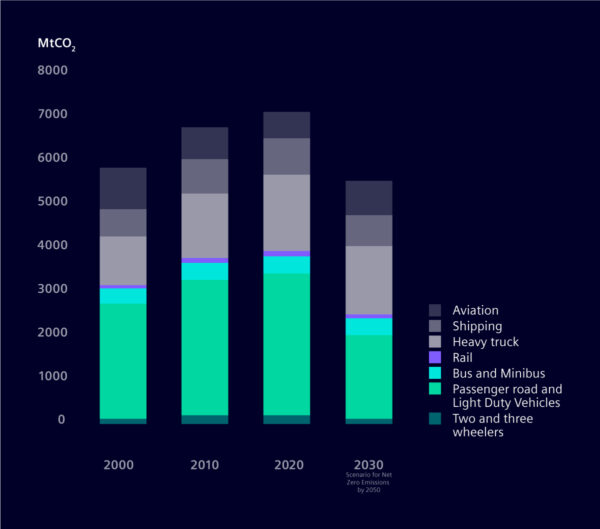
There are significant barriers to EV adoption; however, it is within grasp with further innovations driven by Simcenter solutions.
And there are encouraging signs — the city Shenzhen, China, which has electrified its entire fleet of more than 16,000 buses and nearly 22,000 taxis.
Set an ambitious target. Reduce transport emissions by 20% by 2030. Make target. Set a more ambitious target for 2040 and beyond. Stay on course for net-zero emissions by 2050.
You Might Also Be Interested In:
- BYE AEROSPACE: Airplane manufacturer uses Siemens solutions to reduce product development time for all-electric composite aircraft
- LION ELECTRIC: Electric school bus manufacturer uses Simcenter Amesim for system simulation to optimize battery design and thermal management
- BECKER MARINE SYSTEMS: Leading developer of innovative devices for marine industry uses Simcenter STAR-CCM+ to develop energy-saving Becker Mewis Duct
- Engineers caused the Climate Emergency. Only engineering simulation can save us from it.
- [1] Based on a daily average of 29.2 miles per day – https://newsroom.aaa.com/2015/04/new-study-reveals-much-motorists-drive/
- [2] https://www.icao.int/annual-report-2019/Pages/the-world-of-air-transport-in-2019.aspx
- [3] Using the low-end long-haul flight rate of 150 g of CO2 released per passenger-kilometre


